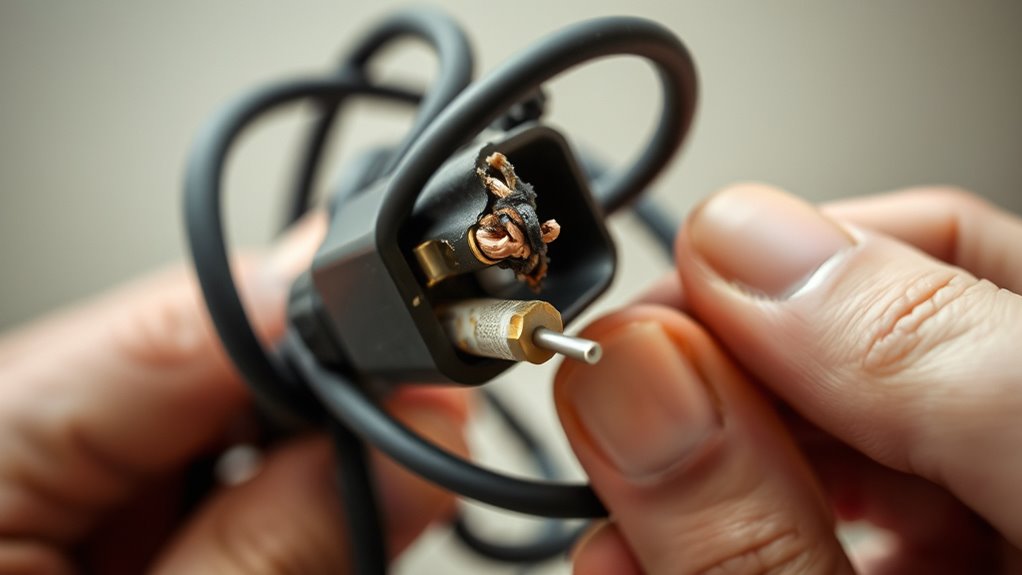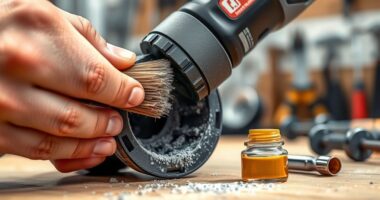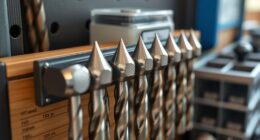To inspect your electrical cords and plugs for damage, regularly look for fraying, cuts, or exposed wires on cords, and check for bent prongs, burn marks, or discoloration on plugs. Avoid using damaged cords or plugs, and replace them immediately if you spot any issues. Handle cords carefully and keep them organized to prevent stress and damage. Continuing with proper inspection practices helps keep your environment safe—learn more about maintaining electrical safety effectively.
Key Takeaways
- Check cords for fraying, cuts, or exposed wires regularly.
- Inspect plugs for bent prongs, discoloration, or burn marks.
- Look for signs of overheating such as discoloration or melting.
- Ensure insulation is intact and free from damage or cracks.
- Unplug and replace damaged cords or plugs immediately to prevent hazards.

Electrical cords and plugs are indispensable for powering your devices, but they can pose safety risks if not properly maintained. Regularly inspecting your cords and plugs is a simple yet pivotal step in guaranteeing cord safety and preventing electrical hazards. When you check your cords, look for visible signs of damage such as fraying, cuts, or exposed wires. These damages can compromise insulation, increasing the risk of shorts or electrical shocks. If you notice any wear and tear, it’s best to replace the cord immediately rather than attempting to repair it with tape or other makeshift fixes. Maintaining the integrity of your cords not only prolongs their lifespan but also keeps your environment safe.
Regularly inspect cords for damage to ensure safety and prevent electrical hazards.
Plug maintenance is equally important. Always inspect the plugs for signs of damage, such as bent prongs, discoloration, or burn marks. Bent prongs can cause poor contact or arcing, which might lead to overheating or sparks. Discoloration or burn marks suggest overheating and potential fire hazards. If a plug shows any of these signs, stop using it and replace it promptly. Never force a damaged plug into a socket; doing so could damage the outlet or increase the risk of electric shock. When plugging and unplugging devices, hold the plug firmly rather than yanking on the cord, which can loosen connections or damage the plug over time.
It’s also essential to keep an eye out for cords that are placed in high-traffic areas or where they might be pinched, bent sharply, or stepped on. Constant stress on a cord, such as bending near the plug or outlet, can weaken insulation and internal wiring. Use cord covers or tape down cords to prevent tripping hazards and minimize damage. If you notice a cord has become hot during use, unplug it immediately. Overheating can be caused by poor connections or overloads, and continued use can result in fire. Additionally, understanding the science behind sound vibrations can help in recognizing signs of overheating, as certain frequencies may indicate electrical issues.
Practicing good cord safety and plug maintenance is straightforward but often overlooked. Make a habit of inspecting your cords and plugs regularly—especially before major use or after any incident that might cause damage. Keep cords organized and away from water or moisture, which can cause shorts or corrosion. Remember, a damaged cord or plug isn’t just a minor inconvenience; it’s a real safety concern. Replacing damaged components promptly and handling cords with care ensures your electrical devices operate safely and efficiently, protecting both your home and loved ones from preventable electrical accidents.
Frequently Asked Questions
How Often Should I Inspect My Electrical Cords?
You should inspect your electrical cords regularly, ideally before each use, to catch any damage early. When storing cords, keep them neatly coiled to prevent wear and tear, and use proper cord labeling to identify their purpose. Frequent inspections help you spot fraying, cracks, or exposed wires, ensuring safety. Proper storage and labeling extend your cords’ lifespan, making maintenance easier and reducing the risk of electrical hazards.
Can Minor Damage Be Safely Repaired?
Think of your electrical cord like a lifeline; even minor damage can jeopardize safety. Minor damage assessment suggests that some small issues, like superficial cuts or worn insulation, might be repairable if you follow proper cord repair safety guidelines. However, if the damage is near the plug or exposes wires, it’s best to replace the cord entirely. Never compromise safety—when in doubt, consult a professional or replace the damaged cord.
What Tools Are Best for Inspecting Cords?
You should use a flashlight and magnifying glass for visual inspection to spot any cracks, frays, or exposed wires. For insulation testing, a dedicated insulation tester or multimeter with insulation testing capability helps verify the cord’s integrity. These tools allow you to thoroughly examine the cord’s condition, ensuring safety. Always unplug the cord before inspecting, and replace any damaged cords immediately to prevent hazards.
Are Certain Types of Cords More Prone to Damage?
Certain cords, like thin, flexible cords with fragile materials, tend to be more prone to damage. You’ll notice that cords with thinner, more delicate designs or those made from softer, less durable materials often wear out faster. Thicker cords built with sturdy cord material resist damage better, making them safer and more reliable. When inspecting cords, check for signs of wear, especially on those with less robust cord thickness and fragile materials.
When Should I Replace Rather Than Repair a Damaged Cord?
You should opt for cord replacement rather than repair when the damage is extensive, such as frayed wiring, exposed conductors, or cracked insulation. Repair safety isn’t reliable for severe issues because it can still pose risks like electrical shock or fire. Always prioritize safety; if you’re unsure, it’s best to substitute the cord to ensure safe operation and avoid potential hazards.
Conclusion
Now, imagine running your fingers along the smooth, flexible cord, feeling for any rough patches or frayed edges that might hide danger. Picture the plug’s prongs, shiny but subtly worn, reminding you that even small cracks can spark trouble. By staying vigilant and regularly inspecting your cords and plugs, you’re not just checking for damage—you’re creating a safeguard, a silent guardian that keeps your home safe and your family protected from unseen hazards lurking beneath the surface.









